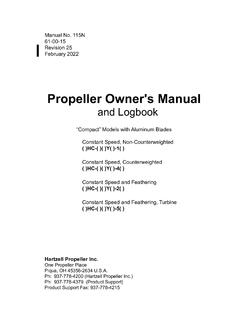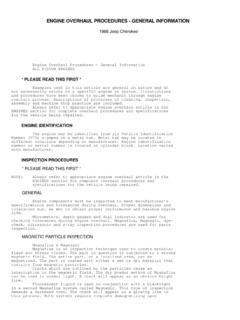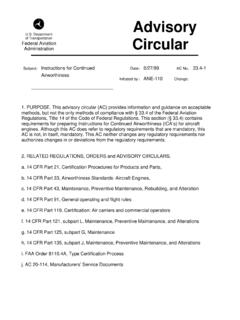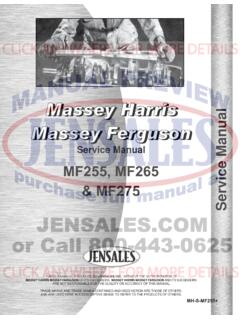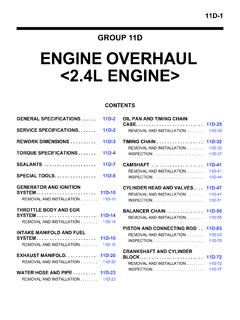Transcription of AC 43-11 - Reciprocating Engine Overhaul Terminology and ...
1 Advisory Circular Subject: Reciprocating Engine Overhaul Terminology and Standards Date: 3/29/07 Initiated by: AFS-350 AC No: 43-11 Change: 1 1. PURPOSE. This advisory circular (AC) has been revised to update references to Title 14 of the Code of Federal Regulations (14 CFR) part 91. 2. PRINCIPLE CHANGES. This change updates all references to 14 CFR part 91 in AC 43-11 . Information on whom you may contact with questions regarding the information in this AC and where you may obtain a copy are also included. PAGE CONTROL CHART Remove Pages Dated Insert Pages Dated 1 thru 4 04/07/76 1 thru 4 3/29/07 ORIGINAL SIGNED BY Roger C. Forshee Jr. for James J. Ballough Director, Flight Standards Service Advisory Circular Subject: Reciprocating Engine Overhaul Terminology and Standards Date: 3/29/07 Initiated by: AFS-350 AC No: 43-11 Change: 1 1. PURPOSE. This advisory circular (AC) discusses Engine Overhaul Terminology and standards used in the aviation industry.
2 This AC will: a. Inform owners or operators of the variety of terms used to describe types of Reciprocating Engine Overhaul ; b. Clarify the standards used by the industry during Reciprocating Engine Overhaul ; and c. Review Title 14 of the Code of Federal Regulations (14 CFR) regarding Engine records and standards. 2. RELATED REGULATORY GUIDANCE. 14 CFR part 43, , (a), and (b) 14 CFR part 91, , , and 3. BACKGROUND. a. For the maintenance of aircraft engines, the aviation industry uses terms such as top Overhaul , major Overhaul , etc. The standards to which an Engine is overhauled usually depends on the terms used by the person who is performing the Engine Overhaul . These terms are familiar to the aviation community, but their specific meanings are not fully understood. This lack of understanding may result in similar engines overhauled to different tolerances. The following discussion should give owners or operators, and Engine Overhaul facilities a better understanding of the terms and standards relating to Engine Overhaul .
3 B. The average aircraft owner usually selects an Overhaul facility based on the cost quoted by the Engine overhauler. Engine overhauls are accomplished to a variety of standards. Many different facilities perform Engine overhauls, ranging from Engine manufacturers, large repair stations, or individual powerplant mechanics. The selection of an Overhaul facility can and does, in most cases, determine the standards used during Overhaul . Section (a) requires the person performing the Overhaul to use methods, techniques, and practices that are acceptable to the Administrator. In most cases, the standards outlined in the Engine manufacturer s Overhaul manual are standards acceptable to the Administrator. AC 43-11 CHG 1 3/29/07 c. Overhaul manuals clearly stipulate the work that must be accomplished during the Engine Overhaul and outline limits and tolerances used during the inspections. There is no dictionary that provides a commonly accepted standard definition of all the terms used in the aviation industry.
4 The terms discussed in this AC are offered for information purposes only and are not to be considered as definitions set forth in 14 CFR. The only definition in 14 CFR regarding Engine Overhaul is the word rebuilt. This is defined in , Rebuilt engines maintenance records. 4. Engine Overhaul Terminology . a. Engine Overhaul Facilities. (1) Engine Overhaul facilities include following: The manufacturer, or a manufacturer s approved agency Large and small Federal Aviation Administration (FAA)-certificated repair stations Engine shops that perform custom overhauls Individual certificated powerplant mechanics (2) These facilities offer various services. Regardless of the type or size of the facility, all are required to comply with (a) and (b). In this regard, it is the responsibility of the owner to assure that proper entries are made in the Engine records in accordance with and Engine Overhaul facilities are required by to make appropriate entries in the Engine records of maintenance that was performed on the Engine .
5 The owner should ensure that the Engine Overhaul facility references the tolerances used (new or serviceable) to accomplish the Engine Overhaul . b. Fits and Limits. Engine Overhaul manuals outline the two kinds of dimensional limits observed during Engine Overhaul as a Table of Limits or a Table of Dimensional Limits. These tables list the parts of the Engine that are subject to wear, and contain minimum and maximum figures for the dimensions of those parts and the clearances between mating surfaces. The lists specify two limits as follows: (1) Manufacturer s Minimum and Maximum. Some manufacturers use the terms new parts or new limits when referring to these dimensional limits. These are the dimensions and standards that all new parts meet as required by 14 CFR for the issuance of a type certificate (TC). It is important to note that new dimensions do not mean new parts are installed in an Engine when a manufacturer, or the manufacturer s authorized representative, presents zero time records in accordance with It does mean that used parts in the Engine were inspected and met the manufacturer s new specifications.
6 Page 2 Par 3 3/29/07 AC 43-11 CHG 1 (2) Service Limits. Service limits are dimensions representing limits that must not be exceeded and are dimension limits for permissible wear. (a) The comparative measurement of parts will determine their serviceability; however, it is not always easy to determine which part has the most wear. The manufacturer s new dimensions or limits are a guide for determining the amount of wear that has occurred during service. In an Engine Overhaul certain parts are replaced regardless of condition. If an Engine is overhauled to serviceable limits, the parts must conform to the fits and limits specifications as listed in the manufacturer s Overhaul manuals and Service Bulletins (SB). (b) If a major Overhaul is performed to serviceable limits or an Engine is top overhauled, the total time on the Engine continues in the Engine records. c. Overhaul . In the general aviation industry, the term Engine Overhaul has two identifications that make a distinction between the degrees of work on an Engine : (1) Major Overhaul .
7 A major Overhaul consists of the complete disassembly of an Engine . The Overhaul facility inspects the Engine , repairs it as necessary, reassembles, tests, and approves it for return to service within the fits and limits specified by the manufacturer s Overhaul data. This could be to new fits and limits or serviceable limits. The Engine owner should clearly understand what fits and limits should be used when the Engine is presented for Overhaul . The owner should also be aware of any replaced parts, regardless of condition, as a result of a manufacturer s Overhaul data, SB, or an Airworthiness Directive (AD). (2) Top Overhaul . Top Overhaul consists of repair to parts outside of the crankcase, and can be accomplished without completely disassembling the entire Engine . It can include the removal of cylinders, inspection and repair to cylinders, inspection and repair to cylinder walls, pistons, valve-operation mechanisms, valve guides, valve seats, and the replacement of piston and piston rings.
8 All manufacturers do not recommend a top Overhaul . Some manufacturers indicate that a powerplant requiring work to this extent should receive a complete Overhaul . d. Rebuilt. (1) A rebuilt Engine as defined in , is a used Engine that has been completely disassembled, inspected, repaired as necessary, reassembled, tested, and approved in the same manner and to the same tolerances and limits as a new Engine with either new or used parts. However, all parts used must conform to the production drawing tolerances and limits for new parts or be of approved oversized or undersized dimensions for a new Engine . (2) The definition of the term rebuilt in allows the owner or operator to use a new maintenance record without previous operating history for an aircraft Engine rebuilt by the manufacturer or an agency approved by the manufacturer. e. Remanufacture. (1) The general term remanufacture has no specific meaning in the regulations.
9 A new Engine is a product that is manufactured from raw materials. These raw materials are made into parts and accessories that conform to specifications for issuance of an Engine s TC. The term Par 4 Page 3 AC 43-11 CHG 1 3/29/07 remanufactured infers that it would be necessary to return the part to its basic raw material and manufacture it again. Remanufactured as used by most Engine manufacturers and Overhaul facilities, means that an Engine has been overhauled to meet the standards required to grant the Engine zero time in accordance with (2) Not all Engine Overhaul facilities which advertise Remanufactured Engines Overhaul engines to new dimensions. Some of these facilities do Overhaul to new dimensions, but may not be authorized to zero time the Engine records. As outlined in , only the manufacturer or an agency approved by the manufacturer can grant zero time to an Engine . 5. CONTACT. For additional information please contact the General Aviation and Avionics Branch, AFS-350, at (202) 267-3546.
10 6. AVAILABILITY. You may obtain a copy of this AC online at Page 4 Par 4










